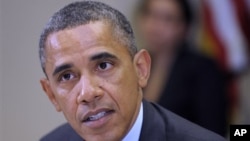WHITE HOUSE — President Barack Obama is authorizing an additional $30 million in federal government help for drought-stricken U.S. farmers and ranchers. America’s continued dry weather will likely affect food and fuel prices worldwide.
The president met Tuesday with officials from several government departments to find ways to help U.S. food producers, who have been hit by a drought he calls “devastating” and “historic.”
Among the steps he is taking is to direct the Agriculture Department to spend $30 million to help provide more water to livestock and to restore land affected by the drought. Obama is also allowing more emergency low-interest loans to crop and livestock producers, and more lending to related small businesses. He also ordered a program to help commercial truck drivers deliver supplies to the stricken areas.
The president said further steps are likely.
“We are going to continue to solicit ideas from state and local organizations, faith-based organizations, not-for-profit groups, the private sector, and most of all, the farmers and ranchers that are directly impacted, to find additional ways that we can help. Because when there is a disaster like this, everyone needs to pull together,” Obama said.
Obama said he has already declared disaster areas in parts of 32 states.
The president also called on Congress to pass the five-year, $500 billion comprehensive farm bill that has passed the Senate, but not the House of Representatives.
“Congress needs to pass a farm bill that will not only provide important disaster relief tools, but also make necessary reforms and give farmers the certainty that they deserve,” Obama said.
Officials say this is one of America’s worst droughts in decades.
Agricultural economist Chris Hurt of Purdue University in Indiana says parched Midwestern cornfields are suffering one of their worst years since the Dust Bowl during the Great Depression.
“Corn yield is one we can track very far back, that we have already passed 1988 as one of the worst droughts in more modern history. Then we really go back to 1934 and 1936,” Hurt said.
Hurt says the shortage of corn and other U.S. farm exports will be felt around the world.
“Since the United States is the largest exporter of basic agricultural goods to the world, that means these higher prices and higher costs for food and fuel will be exported to the world as well,” Hurt said.
Experts say rain and cooler temperatures forecast for this week in parts of the Midwest could help soybean crops, but are too late for the corn.
The president met Tuesday with officials from several government departments to find ways to help U.S. food producers, who have been hit by a drought he calls “devastating” and “historic.”
Among the steps he is taking is to direct the Agriculture Department to spend $30 million to help provide more water to livestock and to restore land affected by the drought. Obama is also allowing more emergency low-interest loans to crop and livestock producers, and more lending to related small businesses. He also ordered a program to help commercial truck drivers deliver supplies to the stricken areas.
The president said further steps are likely.
“We are going to continue to solicit ideas from state and local organizations, faith-based organizations, not-for-profit groups, the private sector, and most of all, the farmers and ranchers that are directly impacted, to find additional ways that we can help. Because when there is a disaster like this, everyone needs to pull together,” Obama said.
Obama said he has already declared disaster areas in parts of 32 states.
The president also called on Congress to pass the five-year, $500 billion comprehensive farm bill that has passed the Senate, but not the House of Representatives.
“Congress needs to pass a farm bill that will not only provide important disaster relief tools, but also make necessary reforms and give farmers the certainty that they deserve,” Obama said.
Officials say this is one of America’s worst droughts in decades.
Agricultural economist Chris Hurt of Purdue University in Indiana says parched Midwestern cornfields are suffering one of their worst years since the Dust Bowl during the Great Depression.
“Corn yield is one we can track very far back, that we have already passed 1988 as one of the worst droughts in more modern history. Then we really go back to 1934 and 1936,” Hurt said.
Hurt says the shortage of corn and other U.S. farm exports will be felt around the world.
“Since the United States is the largest exporter of basic agricultural goods to the world, that means these higher prices and higher costs for food and fuel will be exported to the world as well,” Hurt said.
Experts say rain and cooler temperatures forecast for this week in parts of the Midwest could help soybean crops, but are too late for the corn.





